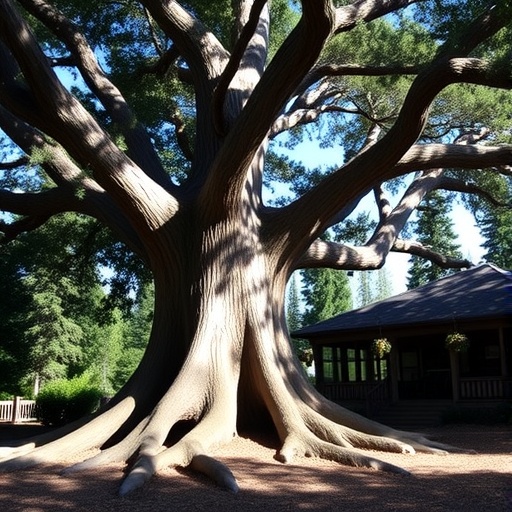For decades, towering trees have stood as silent witnesses to the shifting landscapes of our world, offering a living archive of environmental, cultural, and historical narratives. The National Champion Tree Program, now hosted by the University of Tennessee Institute of Agriculture, has ambitiously compiled an extensive digital archive of giant trees that spans more than 80 years. This unprecedented timeline, accessible for the first time in a consolidated online form, bridges the past with present-day concerns about conservation and urban forestry by cataloging the most massive specimens recorded since the 1940s.
This repository chronicles the evolving relationship between society and its arboreal giants, revealing more than mere measurements of circumference, height, and spread. Early records from the 1940s reflect a period when massive deforestation was propelled by the demands of wartime resource extraction. Back then, tree enthusiasts were not only celebrating these botanical giants but also raising alarms about the sustainability of forest ecosystems amidst global conflict. The program’s archives thus serve as a window into environmental awareness and activism that predate modern conservation movements.
Through systematic documentation, the National Champion Tree Program has illuminated how ecological pressures—ranging from pest infestations to changing climate dynamics—have continually reshaped forest compositions. The digital registries include landmark milestones such as the 50th anniversary of the program in 1990 and the controversial transition to an online format in 2010. Although initially met with resistance from traditionalists who favored printed catalogs, the digital shift has democratized access to data and enriched public engagement with forestry science, enabling a new generation of researchers and citizens to explore arboreal records with greater ease.
The program serves as an intersectional platform that merges botany, ecology, and public history. It elucidates how these natural monuments witness centuries—sometimes millennia—of environmental change. Each champion tree encapsulates a complex ecological narrative, from its growth in diverse soil substrates to survival through episodic droughts, pathogen outbreaks, and anthropogenic disturbances. By mapping the geographic and temporal distribution of champion trees, the program informs both conservation priorities and urban planning strategies.
Modern challenges faced by these venerable trees underscore the urgency of adaptive management strategies. Increasing incidences of invasive pests and pathogens, such as the emerald ash borer and sudden oak death, threaten the health and longevity of forests throughout North America. Coupled with intensifying storm events—driven by global climate change—these biotic and abiotic stressors necessitate vigilant stewardship informed by longitudinal data. The historical registers thus provide a crucial baseline from which to assess the impacts of environmental disruptions over time.
Additionally, the program emphasizes the symbiotic relationship between human communities and their local forest ecosystems. Champion trees often inhabit urban settings where they contribute to biodiversity, provide ecosystem services such as air purification and temperature regulation, and offer aesthetic and cultural value. Maintaining these arboreal giants requires collaboration across governmental agencies, universities, conservation organizations, and engaged citizenry who collectively steward these living relics through changing environmental and social landscapes.
The detailed chronicles of the National Champion Tree Program empower scientists and policy-makers with empirical evidence essential for forest management decisions. For example, by tracking growth trends and health metrics of champion trees, researchers can identify shifts in species distributions linked to climate zones, informing predictive models for future forest composition. Moreover, the program’s long-term datasets foster educational opportunities by providing tangible examples of ecological principles, biological resilience, and conservation ethics.
In an era increasingly characterized by rapid ecological change and biodiversity loss, the significance of champion trees transcends their physical grandeur. They act as sentinel species, sensitive to environmental fluctuations, and their health serves as an indicator of broader ecosystem integrity. The program’s archives enrich our understanding of this sentinel role, and by sharing these records publicly, the University of Tennessee Institute of Agriculture cultivates a wider appreciation and commitment to environmental stewardship.
Looking ahead, the program invites public participation by accepting nominations for new champion trees through December 1 annually, fostering community engagement and the democratization of ecological monitoring. This inclusive approach encourages diverse voices and perspectives in recognizing and preserving natural heritage. It also reinforces the concept that the legacy of champion trees extends beyond their biological lifespan into cultural memory and landscape legacy.
The University of Tennessee’s stewardship of the National Champion Tree Program aligns with its broader mission to advance sustainable management of natural resources. Through interdisciplinary research, teaching, and extension programs, the institute integrates practical, hands-on methodologies with robust scientific inquiry. This holistic approach equips future generations with the tools and knowledge necessary not only to catalog but to protect the ecological treasures that define our shared environmental heritage.
Ultimately, the comprehensive digital timeline of champion trees underscores a profound truth: the choices made today will sculpt the ecological frameworks experienced by descendants far into the future. By celebrating and safeguarding these monumental trees, society honors the deep connections between nature, history, and human well-being. These champions of the forest remind us that our stewardship embodies a covenant with time itself, urging a thoughtful balance between progress and preservation.
The National Champion Tree Program’s contribution to the fields of ecology and plant sciences represents a vital fusion of historical scholarship and contemporary conservation practice. Its archives stand as a testament to the enduring grandeur of nature’s giants and an emblem of the continual human endeavor to harmonize development with environmental resilience. In a rapidly evolving world, this initiative serves as both a scientific repository and a rallying call to recognize and protect the towering sentinels of our natural past and future.
Subject of Research: Not applicable
Article Title: Not provided
News Publication Date: Not provided
Web References:
https://nationalchampiontree.org/historical-registers/
https://nationalchampiontree.org/eligibility-guidelines/
https://naturalresources.tennessee.edu/
https://utia.tennessee.edu/
Image Credits: Photo courtesy National Champion Tree Program
Keywords: Ecology, Plant sciences
Tags: cultural significance of treesdeforestation and wartime resource extractionecological pressures on tree speciesenvironmental awareness through tree recordsevolution of tree measurement techniquesgiant tree digital archivehistorical narratives of giant treeshistory of forestry conservationimpact of climate change on forestsNational Champion Tree Programsustainability in forest ecosystemsurban forestry and conservation





